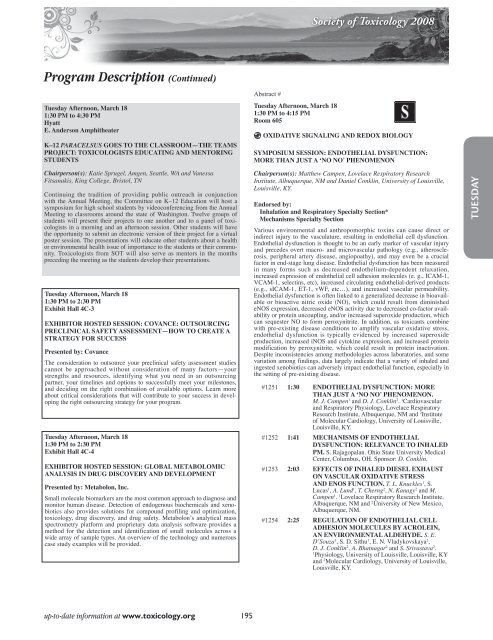Annual Meeting Program - Society of Toxicology
Annual Meeting Program - Society of Toxicology
Annual Meeting Program - Society of Toxicology
Create successful ePaper yourself
Turn your PDF publications into a flip-book with our unique Google optimized e-Paper software.
<strong>Society</strong> <strong>of</strong> <strong>Toxicology</strong> 2008<br />
<strong>Program</strong> Description (Continued)<br />
Tuesday Afternoon, March 18<br />
1:30 PM to 4:30 PM<br />
Hyatt<br />
E. Anderson Amphitheater<br />
K–12 Paracelsus Goes to the Classroom—The TEAMS<br />
Project: Toxicologists Educating and Mentoring<br />
Students<br />
Chairperson(s): Katie Sprugel, Amgen, Seattle, WA and Vanessa<br />
Fitsanakis, King College, Bristol, TN<br />
Continuing the tradition <strong>of</strong> providing public outreach in conjunction<br />
with the <strong>Annual</strong> <strong>Meeting</strong>, the Committee on K–12 Education will host a<br />
symposium for high school students by videoconferencing from the <strong>Annual</strong><br />
<strong>Meeting</strong> to classrooms around the state <strong>of</strong> Washington. Twelve groups <strong>of</strong><br />
students will present their projects to one another and to a panel <strong>of</strong> toxicologists<br />
in a morning and an afternoon session. Other students will have<br />
the opportunity to submit an electronic version <strong>of</strong> their project for a virtual<br />
poster session. The presentations will educate other students about a health<br />
or environmental health issue <strong>of</strong> importance to the students or their community.<br />
Toxicologists from SOT will also serve as mentors in the months<br />
preceding the meeting as the students develop their presentations.<br />
Tuesday Afternoon, March 18<br />
1:30 PM to 2:30 PM<br />
Exhibit Hall 4C-3<br />
Exhibitor Hosted Session: Covance: Outsourcing<br />
Preclinical Safety Assessment—How to Create a<br />
Strategy for Success<br />
Presented by: Covance<br />
The consideration to outsource your preclinical safety assessment studies<br />
cannot be approached without consideration <strong>of</strong> many factors—your<br />
strengths and resources, identifying what you need in an outsourcing<br />
partner, your timelines and options to successfully meet your milestones,<br />
and deciding on the right combination <strong>of</strong> available options. Learn more<br />
about critical considerations that will contribute to your success in developing<br />
the right outsourcing strategy for your program.<br />
Tuesday Afternoon, March 18<br />
1:30 PM to 2:30 PM<br />
Exhibit Hall 4C-4<br />
Exhibitor Hosted Session: Global Metabolomic<br />
Analysis in Drug Discovery and Development<br />
Presented by: Metabolon, Inc.<br />
Small molecule biomarkers are the most common approach to diagnose and<br />
monitor human disease. Detection <strong>of</strong> endogenous biochemicals and xenobiotics<br />
also provides solutions for compound pr<strong>of</strong>iling and optimization,<br />
toxicology, drug discovery, and drug safety. Metabolon’s analytical mass<br />
spectrometry platform and proprietary data analysis s<strong>of</strong>tware provides a<br />
method for the detection and identification <strong>of</strong> small molecules across a<br />
wide array <strong>of</strong> sample types. An overview <strong>of</strong> the technology and numerous<br />
case study examples will be provided.<br />
Abstract #<br />
Tuesday Afternoon, March 18<br />
1:30 PM to 4:15 PM<br />
Room 605<br />
Oxidative Signaling AND Redox Biology<br />
SYMPOSIUM SESSION: ENDOTHELIAL DYSFUNCTION:<br />
MORE THAN JUST A ‘NO NO̓ PHENOMENON<br />
Chairperson(s): Matthew Campen, Lovelace Respiratory Research<br />
Institute, Albuquerque, NM and Daniel Conklin, University <strong>of</strong> Louisville,<br />
Louisville, KY.<br />
Endorsed by:<br />
Inhalation and Respiratory Specialty Section*<br />
Mechanisms Specialty Section<br />
Various environmental and anthropomorphic toxins can cause direct or<br />
indirect injury to the vasculature, resulting in endothelial cell dysfunction.<br />
Endothelial dysfunction is thought to be an early marker <strong>of</strong> vascular injury<br />
and precedes overt macro- and microvascular pathology (e.g., atherosclerosis,<br />
peripheral artery disease, angiopoathy), and may even be a crucial<br />
factor in end-stage lung disease. Endothelial dysfunction has been measured<br />
in many forms such as decreased endothelium-dependent relaxation,<br />
increased expression <strong>of</strong> endothelial cell adhesion molecules (e. g., ICAM-1,<br />
VCAM-1, selectins, etc), increased circulating endothelial-derived products<br />
(e.g., sICAM-1, ET-1, vWF, etc…), and increased vascular permeability.<br />
Endothelial dysfunction is <strong>of</strong>ten linked to a generalized decrease in bioavailable<br />
or bioactive nitric oxide (NO), which could result from diminished<br />
eNOS expression, decreased eNOS activity due to decreased co-factor availability<br />
or protein uncoupling, and/or increased superoxide production, which<br />
can sequester NO to form peroxynitrite. In addition, as toxicants combine<br />
with pre-existing disease conditions to amplify vascular oxidative stress,<br />
endothelial dysfunction is typically evidenced by increased superoxide<br />
production, increased iNOS and cytokine expression, and increased protein<br />
modification by peroxynitrite, which could result in protein inactivation.<br />
Despite inconsistencies among methodologies across laboratories, and some<br />
variation among findings, data largely indicate that a variety <strong>of</strong> inhaled and<br />
ingested xenobiotics can adversely impact endothelial function, especially in<br />
the setting <strong>of</strong> pre-existing disease.<br />
#1251 1:30 ENDOTHELIAL DYSFUNCTION: MORE<br />
THAN JUST A ‘NO NO̓ PHENOMENON.<br />
M. J. Campen 1 and D. J. Conklin 2 . 1 Cardiovascular<br />
and Respiratory Physiology, Lovelace Respiratory<br />
Research Institute, Albuquerque, NM and 2 Institute<br />
<strong>of</strong> Molecular Cardiology, University <strong>of</strong> Louisville,<br />
Louisville, KY.<br />
#1252 1:41 MECHANISMS OF ENDOTHELIAL<br />
DYSFUNCTION: RELEVANCE TO INHALED<br />
PM. S. Rajagopalan. Ohio State University Medical<br />
Center, Columbus, OH. Sponsor: D. Conklin.<br />
#1253 2:03 EFFECTS OF INHALED DIESEL EXHAUST<br />
ON VASCULAR OXIDATIVE STRESS<br />
AND ENOS FUNCTION. T. L. Knuckles 1 , S.<br />
Lucas 1 , A. Lund 1 , T. Cherng 2 , N. Kanagy 2 and M.<br />
Campen 1 . 1 Lovelace Respiratory Research Institute,<br />
Albuquerque, NM and 2 University <strong>of</strong> New Mexico,<br />
Albuquerque, NM.<br />
#1254 2:25 REGULATION OF ENDOTHELIAL CELL<br />
ADHESION MOLECULES BY ACROLEIN,<br />
AN ENVIRONMENTAL ALDEHYDE. S. E.<br />
D’Souza 1 , S. D. Sithu 1 , E. N. Vladykovskaya 2 ,<br />
D. J. Conklin 2 , A. Bhatnagar 2 and S. Srivastava 2 .<br />
1<br />
Physiology, University <strong>of</strong> Louisville, Louisville, KY<br />
and 2 Molecular Cardiology, University <strong>of</strong> Louisville,<br />
Louisville, KY.<br />
Tuesday<br />
up-to-date information at www.toxicology.org 195
















